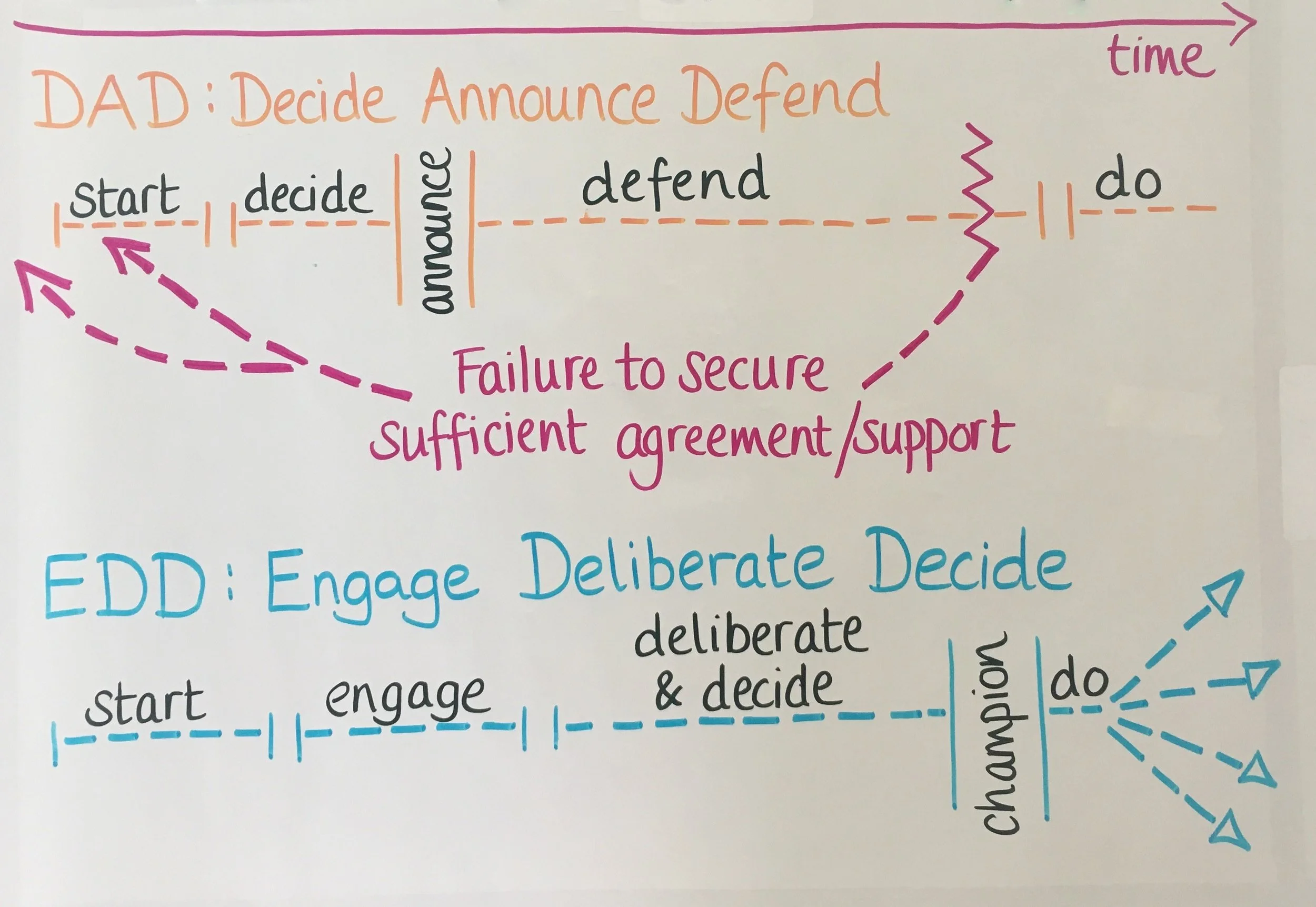DAD and EDD approaches
When an organisation has to make a decision, when is the best time to engage stakeholders about the best option?
If you only ask people what they think when you’ve already made up your mind, you’re taking a big risk. Here’s a quick introduction to Decide-Announce-Defend (Abandon), and its more enlightened cousin Engage-Deliberate-Decide.
Start slower to go further, faster
We’re in a hurry to change things, and it’s so easy to assume that the quicker we can come to a decision, the quicker we can get on and solve the problem. But that’s a mistake.
For many of the complex, wicked and systemic problems we are trying to sort out, time spent in engaging a wide range of people and enabling them to deliberate together leads to smoother, more widely supported and – yes – faster implementation.
DAD in a nutshell
DAD is the Decide-Announce-Defend approach, sometimes ending up as DADA (Decide-Announce-Defend-Abandon). It seems quicker and simpler at first sight, as:
fewer people are involved;
they can use their professional expertise to come up with clever solutions;
and
the hierarchy and power structures they work within ensure decisions get made, and orders are followed, even if not everyone agrees with them. It is a good method for emergencies where speed is essential.
The DAD method is not well suited to situations where:
a wide range of technical, social, cultural and economic factors are influencing the current situation and the various possible alternatives to it;
successful implementation involves a lot of people;
and
these people are not in an obvious command structure, but can choose whether to cooperate.
Think about options for decarbonising heat and power, or how to reduce flood risk in a community, or cutting single-use plastic. Businesses and public bodies need to make recommendations and decisions about these things, and they need the active support of the public and stakeholders if successful strategies are to be found.
In these kinds of contexts – which are so often the case with sustainability issues – the DAD approach is guaranteed to generate resistance to even the best ideas. Resistance eats up time and resources because it needs a response. So the time spent overcoming resistance and defending the solutions against opponents delays implementation and can lead to the plans being abandoned. If they are implemented, it is by a small and defensive group who may feel rather friendless.
EDD
The alternative is the EDD approach: Engage-Deliberate-Decide. This approach positively engages with people’s concerns and needs, starting the conversation early to share the job of understanding the complexity of the current situation, envisaging the better future and planning the path between the two.
Rather than blocking or stifling objections and doubts, they are teased out and worked through in deliberative conversations.
What is it about this situation that concerns you?
What would you like to see?
What else do you need to know, to help you form a view?
What do we need to take account of, to come to a good decision?
Better solutions are more likely to result from careful consideration by a diverse set of stakeholders and people with different lived experience and perspectives.
Although it takes longer to get started, EDD can save time in the long run by growing a large group of ready-made champions willing to advocate for the eventual decision and even roll their sleeves up to make it happen.
Sources and more information
DAD and EDD is a way of thinking about these choices developed and used variously by InterAct Networks, the Sustainable Development Commission, the Environment Agency (as part of its Working With Others approach) and 3KQ, amongst others.
An earlier version of this was published in The Environmentalist, February 2009.
Making the Path by Walking
This post was also including in September’s Making the Path by Walking newsletter. Scroll down to subscribe.

